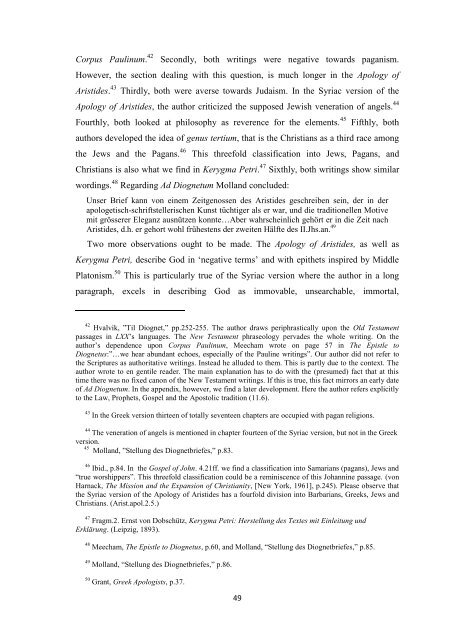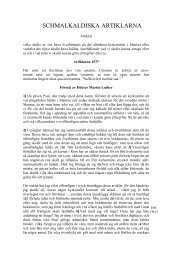MYSTERY REVEALED
MYSTERY REVEALED
MYSTERY REVEALED
Create successful ePaper yourself
Turn your PDF publications into a flip-book with our unique Google optimized e-Paper software.
Corpus Paulinum. 42 Secondly, both writings were negative towards paganism.<br />
However, the section dealing with this question, is much longer in the Apology of<br />
Aristides. 43 Thirdly, both were averse towards Judaism. In the Syriac version of the<br />
Apology of Aristides, the author criticized the supposed Jewish veneration of angels. 44<br />
Fourthly, both looked at philosophy as reverence for the elements. 45 Fifthly, both<br />
authors developed the idea of genus tertium, that is the Christians as a third race among<br />
the Jews and the Pagans. 46 This threefold classification into Jews, Pagans, and<br />
Christians is also what we find in Kerygma Petri. 47 Sixthly, both writings show similar<br />
wordings. 48 Regarding Ad Diognetum Molland concluded:<br />
Unser Brief kann von einem Zeitgenossen des Aristides geschreiben sein, der in der<br />
apologetisch-schriftstellerischen Kunst tüchtiger als er war, und die traditionellen Motive<br />
mit grösserer Eleganz ausnützen konnte…Aber wahrscheinlich gehört er in die Zeit nach<br />
Aristides, d.h. er gehort wohl frühestens der zweiten Hälfte des II.Jhs.an. 49<br />
Two more observations ought to be made. The Apology of Aristides, as well as<br />
Kerygma Petri, describe God in ‘negative terms’ and with epithets inspired by Middle<br />
Platonism. 50 This is particularly true of the Syriac version where the author in a long<br />
paragraph, excels in describing God as immovable, unsearchable, immortal,<br />
42 Hvalvik, ”Til Diognet,” pp.252-255. The author draws periphrastically upon the Old Testament<br />
passages in LXX’s languages. The New Testament phraseology pervades the whole writing. On the<br />
author’s dependence upon Corpus Paulinum, Meecham wrote on page 57 in The Epistle to<br />
Diognetus:”…we hear abundant echoes, especially of the Pauline writings”. Our author did not refer to<br />
the Scriptures as authoritative writings. Instead he alluded to them. This is partly due to the context. The<br />
author wrote to en gentile reader. The main explanation has to do with the (presumed) fact that at this<br />
time there was no fixed canon of the New Testament writings. If this is true, this fact mirrors an early date<br />
of Ad Diognetum. In the appendix, however, we find a later development. Here the author refers explicitly<br />
to the Law, Prophets, Gospel and the Apostolic tradition (11.6).<br />
43 In the Greek version thirteen of totally seventeen chapters are occupied with pagan religions.<br />
44 The veneration of angels is mentioned in chapter fourteen of the Syriac version, but not in the Greek<br />
version.<br />
45 Molland, ”Stellung des Diognetbriefes,” p.83.<br />
46 Ibid., p.84. In the Gospel of John. 4.21ff. we find a classification into Samarians (pagans), Jews and<br />
“true worshippers”. This threefold classification could be a reminiscence of this Johannine passage. (von<br />
Harnack, The Mission and the Expansion of Christianity, [New York, 1961], p.245). Please observe that<br />
the Syriac version of the Apology of Aristides has a fourfold division into Barbarians, Greeks, Jews and<br />
Christians. (Arist.apol.2.5.)<br />
47 Fragm.2. Ernst von Dobschütz, Kerygma Petri: Herstellung des Textes mit Einleitung und<br />
Erklärung. (Leipzig, 1893).<br />
48 Meecham, The Epistle to Diognetus, p.60, and Molland, “Stellung des Diognetbriefes,” p.85.<br />
49 Molland, “Stellung des Diognetbriefes,” p.86.<br />
50 Grant, Greek Apologists, p.37.<br />
49



